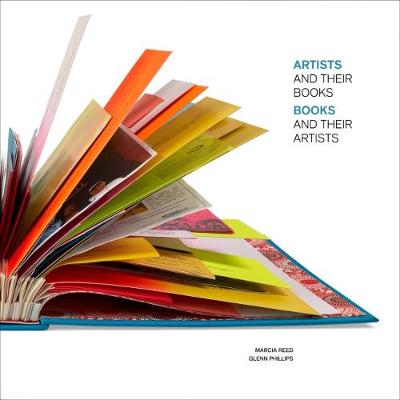BIBLIOTHECA PAEDIATRICA REF KARGER
2 total works
Artists and Their Books, Books and Their Artists
by Marcia Reed and Glenn Phillips
Published 10 July 2018
Ever innovative and predictably diverse in their physical formats, artists' books occupy a creative space between the familiar four-cornered object and challenging works of art that effectively question every preconception of what a book can be. Many artists specialize in producing self-contained art projects in the form of books, like Ken Campbell and Susan King, or they establish small presses, like Simon Cutts and Erica Van Horn's Coracle Press or Harry and Sandra Reese's Turkey Press. Countless others who are primarily known as sculptors, painters, or performance artists carry on a parallel practice in artists' books, including Anselm Kiefer, Annette Messager, Ed Ruscha, and Richard Tuttle. Artists and Their Books / Books and Their Artists includes eighty important examples selected from the Getty Research Institute's Special Collections of more than six thousand editions and unique artists' books.
This elegant catalogue also presents precursors to the artist's book, such as Joris Hoefnagel's sixteenth-century calligraphy masterpiece; single-sheet episodes from Albrecht DuIA rer's Life of Mary, designed to be either broadsides or a book; early illustrated scientific works; and avant-garde publications. Twentieth-century works reveal the impact of artists' books on Pop art, Fluxus, Conceptual, feminist art, and postmodernism. The selection of books by an international range of artists who have chosen to work with texts and images on paper provokes new inquiry into the nature of art and books in contemporary culture.
This elegant catalogue also presents precursors to the artist's book, such as Joris Hoefnagel's sixteenth-century calligraphy masterpiece; single-sheet episodes from Albrecht DuIA rer's Life of Mary, designed to be either broadsides or a book; early illustrated scientific works; and avant-garde publications. Twentieth-century works reveal the impact of artists' books on Pop art, Fluxus, Conceptual, feminist art, and postmodernism. The selection of books by an international range of artists who have chosen to work with texts and images on paper provokes new inquiry into the nature of art and books in contemporary culture.
Harald Szeemann - Museum of Obsessions
by Glenn Phillips, Philipp Kaiser, Doris Chon, and Pietro Rigolo
Published 10 April 2018
Harald Szeemann is associated with some of the most important artistic developments of the postwar era. A passionate
advocate of avant-garde movements like conceptualism and post minimalism, he collaborated with artists such as Joseph
Beuys, Bruce Nauman, Richard Serra, and Cy Twombly, developing new ways of presenting art that reflected his
sweeping vision of contemporary culture.
Szeemann once stated that his goal as an exhibition maker was to create a "Museum of Obsessions." This richly
illustrated volume is a virtual collection catalogue for that imaginary institution, tracing the evolution of his curatorial
method through the materials he collected and produced while researching and organising his exhibitions, including
letters, drawings, personal datebooks, installation plans, artists' books, posters, photographs, and handwritten notes.
This book documents all phases of Szeemann's career, from his early stint as director of the Kunsthalle Bern, where he
organized the seminal Live in Your Head: When Attitudes Become Form (1969); to documenta 5 (1972) and the intensely
personal exhibition he staged in his own apartment using the belongings of his hairdresser grandfather (1974); to his
reinvention as a freelance curator who realised projects on wide-ranging themes until his death in 2005.
The book contains essays exploring Szeemann's curatorial approach as well as interviews with collaborators. Its more
than 350 illustrations include previously unpublished installation photographs and exhibition documents as well as many
other materials from the curator's archive.
advocate of avant-garde movements like conceptualism and post minimalism, he collaborated with artists such as Joseph
Beuys, Bruce Nauman, Richard Serra, and Cy Twombly, developing new ways of presenting art that reflected his
sweeping vision of contemporary culture.
Szeemann once stated that his goal as an exhibition maker was to create a "Museum of Obsessions." This richly
illustrated volume is a virtual collection catalogue for that imaginary institution, tracing the evolution of his curatorial
method through the materials he collected and produced while researching and organising his exhibitions, including
letters, drawings, personal datebooks, installation plans, artists' books, posters, photographs, and handwritten notes.
This book documents all phases of Szeemann's career, from his early stint as director of the Kunsthalle Bern, where he
organized the seminal Live in Your Head: When Attitudes Become Form (1969); to documenta 5 (1972) and the intensely
personal exhibition he staged in his own apartment using the belongings of his hairdresser grandfather (1974); to his
reinvention as a freelance curator who realised projects on wide-ranging themes until his death in 2005.
The book contains essays exploring Szeemann's curatorial approach as well as interviews with collaborators. Its more
than 350 illustrations include previously unpublished installation photographs and exhibition documents as well as many
other materials from the curator's archive.

